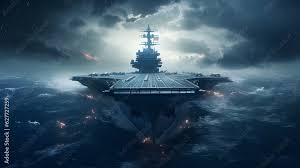
In a rare fit of martial sobriety, the notoriously woke and retarded “War on the Rocks” site published a compelling essay on pulling the US back from the brink and hinted at going a little easy on the Dr. Evil global hegemon routine that has possessed the US military for decades.
The opposite is true. A navy tasked to do all these things cannot do them all well. Rolling back presence will strengthen, not weaken, deterrence. For too long, short-term thinking has taken priority over managing long-term risk. It’s time to flip the script. Readiness for great-power conflict — peace through strength rather than global policing — should once again be America’s primary grand-strategic aim.
As the hulls plowed through the world’s oceans, the bills started coming due as the wheels fell off. The point of no return beckons.
Like a car, a ship can only be run so hard until it becomes too expensive to maintain. As the Navy overused its ships, they retired early. Other ships picked up their slack and were then overused themselves. To support the rising tempo of operations, the Navy repeatedly delayed maintenance on ships. America’s shipyards, which required predictable contracts to remain economically viable, bled skilled laborers, driving up costs in an endless cycle.
The result was that the surface fleet shrank from over 400 ships in 1994 to an all-time-low of 272 vessels during the Obama administration (today, it sits at around 300). Even with an ongoing multi-decade, multi-billion-dollar investment in the nation’s public shipyards, the U.S. Navy will not clear its maintenance backlogs until at least 2040. Even the chief of naval operations recently acknowledged that the fleet will not grow any time soon. Wargames indicate that, were the United States to fight China, the U.S. Navy might eke out a nominal win, but one that blurs the line between victory and defeat, setting back American military power for a generation.
Now the world is full of compromises and if you press for a high mileage readiness presence forward, you lose the military edge to have large ship formations in high states of readiness that can operate together in peer conflict. Now I am suspending my disbelief in the ability of the USN to fight its surface fleet against a peer with overwhelming missile salvo advantage but the author makes tremendous observations nonetheless.
Everyone, from the combatant commanders to the Navy, lost sight of the trade-off between operational and structural readiness. “Operational” readiness refers to the ability of existing military units to fight tonight. “Structural” readiness refers to a military’s ability to generate sufficient mass for multiple rounds in a prolonged fight, including factors like the health of the defense-industrial base. In basic terms, an extremely high level of operational readiness is required for global policing duties; whereas if the goal is fighting a long war against a peer competitor, structural readiness is more important. If resources are finite (which they always are), the two trade off.
In brief, for three decades, the U.S. Navy traded its structural readiness (for great-power conflict) for operational readiness (to support naval forward presence). It burned through its ships, and debilitated its shipyards, to make sure it could respond to whatever policymakers wanted, whenever they wanted it, no matter how irrelevant it was to deterrence and warfighting.
There is no shipyard throughput nor the talent to staff the shipyards to build to make up for this tremendous martial malpractice. Panter is a bit more optimistic than I am but the news is that the US Navy has entered a death spiral from which it may not recover.
In sum, everyone’s favorite solution to the mismatch between operational demands and ship supply — increased shipbuilding — will not work on its own. Operational demands should fall in tandem, to buy time to increase the fleet’s size and restore the structural readiness of the existing force. The stigma around questioning naval forward presence should end. Global policing, and the reflexive elevation of near-term goals over long-term risk, no longer works.
Not only do we simply lack the infrastructure to increase ship building capacity along with the legions of varied tradesmen and talent stacks but the US has neglected a bill that’s come due that will take a minimum of two decades to remedy. This does not get resolved overnight. Meanwhile China may very well become the preeminent blue water naval surface power on earth and aboslutely dominate the contiguous saltwater proximate to their coastline.
Rolling Back Naval Forward Presence Will Strengthen American Deterrence













